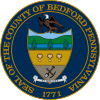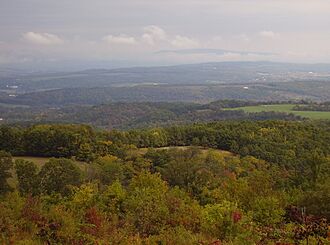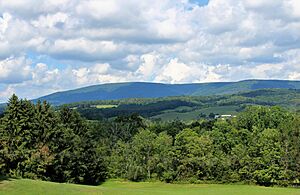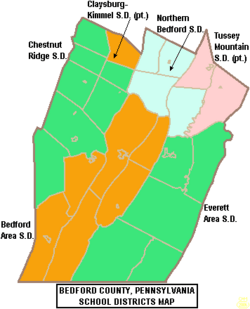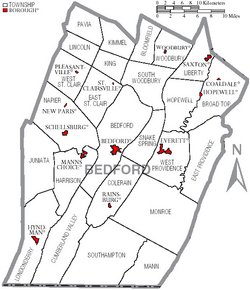Bedford County, Pennsylvania facts for kids
Quick facts for kids
Bedford County
|
|||
|---|---|---|---|
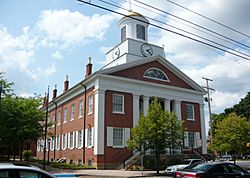
Bedford County Courthouse
|
|||
|
|||
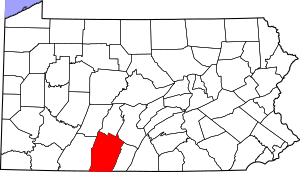
Location within the U.S. state of Pennsylvania
|
|||
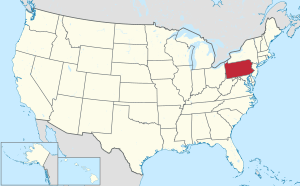 Pennsylvania's location within the U.S. |
|||
| Country | |||
| State | |||
| Founded | March 9, 1771 | ||
| Named for | Fort Bedford | ||
| Seat | Bedford | ||
| Largest borough | Bedford | ||
| Area | |||
| • Total | 1,017 sq mi (2,630 km2) | ||
| • Land | 1,012 sq mi (2,620 km2) | ||
| • Water | 4.6 sq mi (12 km2) | ||
| Population
(2020)
|
|||
| • Total | 47,577 | ||
| • Density | 47/sq mi (18/km2) | ||
| Time zone | UTC−5 (Eastern) | ||
| • Summer (DST) | UTC−4 (EDT) | ||
| Congressional district | 13th | ||
|
Pennsylvania Historical Marker
|
|||
| Designated: | October 17, 1982 | ||
Bedford County is a county in Pennsylvania, a state in the United States. In 2020, about 47,577 people lived here. The main town, or county seat, is Bedford. This county is part of the Southwest Pennsylvania region.
Contents
History of Bedford County
Early Times (1700s)
In 1750, a man named Robert MacRay started the first trading post in what is now Bedford County. It was in a place called Raystown (now Bedford). Early settlers from Europe had a tough time because Native Americans sometimes raided their homes. From 1754, there was a lot of fighting. Native American groups chose sides with either the British or the French during the French and Indian War. This war was part of a bigger conflict in Europe.
In 1759, after the British took over Fort Duquesne, they built a road. This road connected the renamed Fort Pitt to a new fort called Fort Bedford in Raystown. The British won the war, gaining control of French lands in North America. Treaties with Native Americans then opened up more land for people to settle peacefully.
This road was built on old Native American trails. Later, it became a wider, paved road known as "Forbes Road." Today, it's Route 30. When the Pennsylvania Turnpike was built, it became the main highway through Bedford County.
Bedford County was officially created on March 9, 1771. It was formed from a part of Cumberland County. The county was named after Fort Bedford. After the American Revolution, more people moved to the area. Over time, parts of Bedford County were used to create other counties. For example, Huntingdon County was formed in 1787. Somerset County was created in 1795. Eventually, Fulton County was formed in 1850, setting Bedford County's current borders.
The land became rich farmland with many forests. It grew into an important trading spot for people traveling to Pittsburgh and other parts of western Pennsylvania. In 1794, President George Washington even visited the county. He came because of the Whiskey Rebellion, a protest by farmers.
Later Years (1800s)
In the late 1800s, the Bedford Springs Hotel became a popular place for rich people to vacation. It was built near natural springs that Native Americans had used for hundreds of years. President James Buchanan even moved his government to the hotel for a summer. It became like a summer White House. The U.S. Supreme Court met there once, which was the only time it met outside of Washington, D.C..
During this time, the county's population grew a lot. It doubled between 1870 and 1890. Railroads were built, connecting the county to the mining industry. The famous story of the Lost Children of the Alleghenies comes from Blue Knob State Park in the county.
Geography of Bedford County
Bedford County covers about 1,017 square miles. Most of this is land, with a small amount of water. The weather here is a humid continental climate. This means it has warm summers and cold winters.
Natural Features
- Evitts Mountain
- Morrison Cove
- Tussey Mountain
- Blue Knob, which is the tallest mountain in the county. It's about 3,120 feet high!
Neighboring Counties
- Blair County (north)
- Huntingdon County (northeast)
- Fulton County (east)
- Allegany County, Maryland (south)
- Somerset County (west)
- Cambria County (northwest)
Geology (Rocks and Land)
Bedford County is in a region with many folded and faulted rocks. These rocks are very old. The western edge of the county is near the Allegheny Front. This is where the land changes from folded mountains to flatter areas.
The main mountains in the county, like Wills, Evitts, and Tussey, are made of strong rock called quartz sandstone. Broad Top is a flatter area with younger rocks.
The Raystown Branch of the Juniata River flows through the northern part of the county. It cuts through the mountains in several places. This river eventually flows into Raystown Lake in Huntingdon County. The southern part of the county drains into the Potomac River. Both the Potomac and Juniata rivers are part of the Chesapeake Bay Watershed.
Bedford County has several limestone quarries. These are places where limestone rock is dug out of the ground. There are also two areas with coal. In some places, old coal mines cause acid mine drainage, which can harm streams.
Natural gas can also be found in the county. There are gas fields in the southeastern part, especially near Breezewood.
People of Bedford County
| Historical population | |||
|---|---|---|---|
| Census | Pop. | %± | |
| 1790 | 13,132 | — | |
| 1800 | 12,039 | −8.3% | |
| 1810 | 15,746 | 30.8% | |
| 1820 | 20,248 | 28.6% | |
| 1830 | 24,502 | 21.0% | |
| 1840 | 29,335 | 19.7% | |
| 1850 | 23,052 | −21.4% | |
| 1860 | 26,736 | 16.0% | |
| 1870 | 29,635 | 10.8% | |
| 1880 | 34,929 | 17.9% | |
| 1890 | 38,644 | 10.6% | |
| 1900 | 39,468 | 2.1% | |
| 1910 | 38,879 | −1.5% | |
| 1920 | 38,277 | −1.5% | |
| 1930 | 37,309 | −2.5% | |
| 1940 | 40,809 | 9.4% | |
| 1950 | 40,775 | −0.1% | |
| 1960 | 42,451 | 4.1% | |
| 1970 | 42,353 | −0.2% | |
| 1980 | 46,784 | 10.5% | |
| 1990 | 47,919 | 2.4% | |
| 2000 | 49,976 | 4.3% | |
| 2010 | 49,762 | −0.4% | |
| 2020 | 47,577 | −4.4% | |
In 2010, there were about 49,762 people living in Bedford County. Most people (98%) were White. About 29% of homes had children under 18 living there. The average age of people in the county was about 43.9 years old.
2020 Census Information
| Race | Number of People | Percentage |
|---|---|---|
| White | 45,381 | 95.4% |
| Black or African American | 181 | 0.4% |
| Native American | 66 | 0.14% |
| Asian | 153 | 0.32% |
| Pacific Islander | 0 | 0% |
| Other/Mixed | 1,277 | 2.7% |
| Hispanic or Latino | 519 | 1.1% |
Education in Bedford County
Students in Bedford County attend different schools.
Public School Districts
- Bedford Area School District
- Chestnut Ridge School District
- Claysburg-Kimmel School District (also in Blair County)
- Everett Area School District
- Northern Bedford County School District
- Tussey Mountain School District (also in Huntingdon County)
Public Charter Schools
- HOPE for Hyndman Charter School, Hyndman
Students in Pennsylvania can also attend online cyber charter schools.
Public Technical School
- Bedford County Technical Center
Private Schools
- Allegheny Valley Christian School, Schellsburg
- Christian Light School, Bedford
- Dry Hill Parochial School, Woodbury
- Friends Cove Mennonite School, Bedford
- Global Power Line Academy, Claysburg
- Golden Rule School, Martinsburg
- Learning Lamp at Everett, Everett
- Little Learning Lamp
- Lone Oak Mennonite School, New Enterprise
- Noahs Ark Kindergarten, New Park
- Snake Spring Valley Christian Academy, Inc, Everett
- South Cove Parochial School, New Enterprise
- Saint Thomas School, Bedford, Pennsylvania, Bedford
- Sunny Slope School, Woodbury
- Woodbury Mennonite School, Woodbury
Colleges
- Allegany College of Maryland has a campus in Everett.
Transportation in Bedford County
Main Highways


 I-70 / I-76 / Penna Turnpike
I-70 / I-76 / Penna Turnpike I-99
I-99 US 30
US 30
 US 30 Bus.
US 30 Bus. US 220
US 220


 US 220 Bus.
US 220 Bus. PA 26
PA 26 PA 31
PA 31 PA 36
PA 36 PA 56
PA 56 PA 96
PA 96 PA 164
PA 164 PA 326
PA 326 PA 671
PA 671 PA 866
PA 866 PA 867
PA 867 PA 868
PA 868 PA 869
PA 869 PA 913
PA 913 PA 915
PA 915
Airports
The Bedford County Airport is open to the public. It is located north of the town of Bedford, Pennsylvania.
Recreation in Bedford County
Bedford County has many places for fun and outdoor activities.
- Blue Knob State Park is a great place for skiing and other activities.
- Shawnee State Park
- Warriors Path State Park
The largest park owned by a town is Tenley Park in Everett. It's 77 acres and open to everyone. The Mid State Trail and Great Eastern Trail also pass through Everett and Tenley Park.
Communities in Bedford County
In Pennsylvania, there are different types of towns and areas. Here are the ones in Bedford County:
Boroughs (Towns)
- Bedford (This is the county seat, the main town)
- Coaldale
- Everett
- Hopewell
- Hyndman
- Manns Choice
- New Paris
- Pleasantville
- Rainsburg
- St. Clairsville
- Saxton
- Schellsburg
- Woodbury
Townships (Rural Areas)
- Bedford
- Bloomfield
- Broad Top
- Colerain
- Cumberland Valley
- East Providence
- East St. Clair
- Harrison
- Hopewell
- Juniata
- Kimmel
- King
- Liberty
- Lincoln
- Londonderry
- Mann
- Monroe
- Napier
- Pavia
- Snake Spring
- South Woodbury
- Southampton
- West Providence
- West St. Clair
- Woodbury
Census-Designated Places (CDPs)
These are areas that are like towns but not officially incorporated.
Other Communities
Population Ranking
This table shows the biggest towns and areas in Bedford County based on the 2010 census.
† county seat
| Rank | City/Town/etc. | Population (2010 Census) | Type of Community | Year Founded |
|---|---|---|---|---|
| 1 | † Bedford | 2,841 | Borough | 1795 |
| 2 | Everett | 1,834 | Borough | 1860 |
| 3 | Earlston | 1,122 | CDP | |
| 4 | Hyndman | 910 | Borough | 1877 |
| 5 | Saxton | 736 | Borough | 1867 |
| 6 | Stonerstown | 376 | CDP | |
| 7 | Schellsburg | 338 | Borough | 1838 |
| 8 | Manns Choice | 300 | Borough | 1886 |
| 9 | Woodbury | 284 | Borough | 1868 |
| 10 | Defiance | 239 | CDP | |
| 11 | Hopewell | 230 | Borough | 1895 |
| 12 | Pleasantville | 198 | Borough | 1871 |
| 13 | New Paris | 186 | Borough | 1882 |
| 14 | Coaldale | 161 | Borough | 1865 |
| 15 | Rainsburg | 133 | Borough | 1856 |
| 16 | St. Clairsville | 78 | Borough | 1867 |
See also
 In Spanish: Condado de Bedford (Pensilvania) para niños
In Spanish: Condado de Bedford (Pensilvania) para niños



